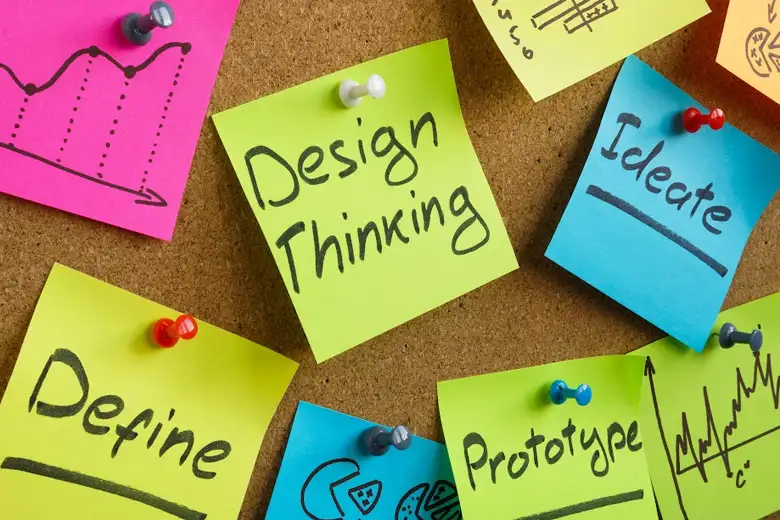What is Design Thinking, how can you use it to improve your products and services, and how does it promote innovation? We answer all this and more in our article.
Design Thinking is a creative, empathy-driven approach to solving user challenges and improving products that have gained significant traction across different industries in recent years. The process stands apart from more traditional, analytical approaches to design as its focus lies in deeply understanding the needs and desires of target users. This approach ensures that solutions are not only effective from a functionality or usability perspective but also fully aligned with the challenges faced by real people.
But what benefits does the Design Thinking process bring about for design teams and their users and how does it drive innovation? In this article, we explore the topic of Design Thinking and innovation. By the end, you’ll know what it means to look at projects through a Design Thinking lens, how to incorporate the process into your own workflow, and the impact this approach has on innovation within your design team.
We’ll be covering the following topics:
- What is Design Thinking?
- What are the principles of Design Thinking?
- What are the benefits of Design Thinking?
- How do you use Design Thinking for innovation?
- Conclusion
Ready to learn more? Then read on!
What is Design Thinking?
With a sharp focus on flexibility, continuous refinement, and the user experience, Design Thinking is a popular problem-solving methodology used by designers and project managers that has empathy, innovation, and creativity at its heart. The Design Thinking process involves researching and understanding the needs of users, identifying and defining challenges, brainstorming solutions, and creating prototypes for ongoing testing and improvement.
While Design Thinking is a popular approach within design teams, its application is not limited to the field of design. Due to its ability to foster innovation, inspire creativity, and develop solutions, Design Thinking is frequently adopted in industries as varied as education, business, healthcare, and technology to support the creation of products and services that are highly effective and user-centered.

What are the principles of Design Thinking?
Let’s dive into the principles of Design Thinking and what they lend to the product development process.
1. Empathy
Empathizing in Design Thinking refers to trying to fully understand the challenges, needs, and experiences of those interacting with a product or service and coming up with solutions that really help them. As well as being a principle of Design Thinking, it is also often the first stage of the process. Empathy is considered by many to be the founding principle of this approach as it ensures that all creative problem solving is informed by human insights.
2. Define
The Define principle requires the design team to clearly state the challenge that has been identified during the Empathy stage. This is often articulated via a problem statement which is then used to guide the rest of the design thinking process. By having the problem statement ever-present, the team stays on track and focused on solving the identified issue.

3. Ideate
In order to tackle the problem that has been defined, ideation is required. This part of the Design Thinking process incorporates a range of methodologies such as brainstorming, crowdsourcing, and mind mapping to encourage teams to think outside of the box. Those running ideation sessions seek to foster innovation and collaborative creativity.
4. Prototype
Once an idea has been chosen, a team is ready to start prototyping. This phase involves the creation of different representations of the idea, usually beginning with wireframe sketches and graduating onto interactive prototypes that explore the idea in practical and visual ways. The purpose of the prototyping phase is to help the team get a real feel for the selected idea and have the opportunity to test it before investing further resources.
5. Test
With a prototype created, teams can start testing the idea to see how well it holds up to scrutiny. Testing involves gathering feedback from other designers, users, and project stakeholders via a range of methods including usability testing, questionnaires, focus groups, and observation. The goal here is to use the feedback to validate assumptions, identify challenges, and pinpoint ways to improve the product’s usability.
6. Iterate
Iteration involves refining and improving the product through the repetition of the previous cycles: prototyping, testing, and gathering feedback. This is a cyclical process during which designers continuously run through the previous phases until the team feels satisfied that user needs are being met and all challenges have been resolved.
7. Human-centered
Design Thinking is a human-centered process. This means that the needs, challenges, motivations, and limitations of product users are at the heart of all design decisions. By placing user requirements and preferences at the center of the process, one can ensure the final product is accessible, meaningful, relevant, and functional for all who need it.
8. Collaboration
Design Thinking requires collaboration to bring together a range of different ideas, views, skills, and experiences in order for challenging issues to be effectively overcome. Teamwork is therefore a vital part of the process, with open communication, shared ideas, and collective creativity actively encouraged.

What are the benefits of Design Thinking?
Let’s take a look at the benefits that teams can expect when they adopt a Design Thinking approach.
1. User-centric solutions
The Design Thinking process creates user-centric solutions. This is because the needs, challenges, desires, perspectives, feedback, and experiences of users are at the core of the methodology. The insights uncovered during the empathy stage of the process are what power the solution-creation and ideation phase, ensuring that the design team creates products that are not only user-centric but also highly effective and deeply meaningful.
2. Boosted experimentation and creativity
Design Thinking promotes experimentation and encourages design teams to act without fear of failure. This approach helps teams feel free to try out different ideas, test quickly and often, be more creative and experimental, and immerse themselves in the exploration of less conventional concepts. The result? Out-of-the-box solutions that more effectively meet the real needs of users.
3. Support in defining problems
It’s easy to underestimate the value of defining a problem accurately. However, if a team falsely identifies and defines a design flaw, significant resources can be wasted on trying to solve the wrong issue. By honing in on user needs, preferences, behavior, and experiences, Design Thinking ensures that problems are identified and defined accurately. This is hugely beneficial for design teams as it means their efforts and resources are put towards solving the right challenges.
4. Collaboration and inclusivity
Collaboration and inclusivity are promoted throughout each phase of the Design Thinking process, benefiting design teams and ultimately their users too. Collaboration and inclusivity are advantageous because when diverse perspectives, skill sets, and experiences are brought together, a team is more likely to come up with more innovative solutions. As a best practice, different voices should always be sought out during the design process in order to guarantee the creation of an end product that is inclusive and accessible to a wide audience.
5. Increased innovation
Through the range of ideation methods that are encouraged in the Design Thinking process, design teams can come up with solutions that are more innovative and experimental than when traditional ideation methods are employed. Design Thinking facilitates new possibilities, approaches, and solutions that can radically increase the chances of a product’s success.
6. Better understanding of users
With empathy being a defining principle of Design Thinking, the process helps teams to learn about their users in depth. When designers have the space and resources to delve into who their users are, they are able to develop solutions that are more aligned with what those users really need, building stronger and longer-lasting user-brand relationships.
7. Alternative perspectives
“Groupthink” is a common problem in many organizations. This is when the desire for consensus within a team overrides critical thinking, leading to the suppression of different viewpoints. By encouraging teams to look at challenges from a range of different angles, Design Thinking mitigates the occurrence of groupthink. This celebration of different perspectives instead leads to increased innovation and therefore more successful solutions.
8. Improved usability of products
Design Thinking places great emphasis on user needs, extensive testing, and continuous iteration. This approach leads to the creation of products that are more usable, intuitive, accessible, and user-friendly. When teams incorporate the Design Thinking process into their workflow, not only is user satisfaction boosted but there is also a wider adoption of the final product by more diverse audiences.
9. Streamlines innovation
Thanks to the structured and iterative process that Design Thinking advocates for, a team’s approach to innovation is much more effectively streamlined, from problem identification through to solution development. Ideas are validated at speed due to the emphasis on rapid prototyping and testing, and costly mistakes are minimized or avoided altogether. With the focus on user needs and ongoing feedback, a design team’s solutions are both more effective and relevant to specific user groups. In addition, continuous refinement accelerates innovation which leads to more impactful results.

How do you use Design Thinking for innovation?
The Design Thinking process fosters innovation in several important ways and at every stage.
When the design team immerses themselves in the users’ experiences during the empathy stage of the process, they ensure that later innovation solves real user issues rather than abstract ideas or assumed problems.
During the definition stage of the process, the team brings together their findings to produce a problem statement that accurately articulates the challenge that will be solved during the project. In terms of innovation, this step is critical. By producing a well-defined problem, the team has a guide to follow for the entire innovation process. This ensures that the team’s efforts and resources are focused on creative solutions that really impact the experience of users.
The next phase is ideation. This is the time when the team really gets the chance to be experimental and creative without judgment. Different ideation methodologies are employed here such as free-flowing idea generation, brainstorming, and creative problem-solving. Breaking the pattern of thinking within the constraints of conventional solutions, the team facilitates out-of-the-box thinking and creates space for groundbreaking innovation. Thanks to the collaborative approach encouraged by Design Thinking, this part of the process often leads to innovative ideas that individual designers may not have thought of alone.
Prototyping also supports innovation. As we have seen, this part of the process transforms the team’s concepts and ideas into tangible forms such as wireframes or interactive digital prototypes that can be tested, refined, and improved. The creation of prototypes enables designers to visualize their ideas, explore the validity and feasibility of their concepts, experiment with different solutions, and quickly identify potential flaws or user challenges, prioritizing (informed) innovation above all else. The collaborative nature of prototyping also facilitates innovation as feedback can be rapidly shared, making iterations faster and improving decision-making.
When it comes to the testing phase of the Design Thinking process, the insights gathered from users further drive design innovation and creativity. Users can clarify what works, what doesn’t work, what they like, and what changes they’d like to see. During the iteration phase, this feedback is used to inform design changes. Iteration ensures that innovation is a continuous evolution that uncovers more impactful solutions over time.
For a deeper understanding of how applying Design Thinking benefits designers, check out this Task-Based Application project by AND learner, Shantanu Pathak.
Conclusion
There you have it! A complete guide to the benefits of Design Thinking and how you can use it to promote and facilitate innovation within your design team. With empathy and creativity at its heart, Design Thinking ensures that all of your design decisions are centered around solving user challenges in ways that push the boundaries of innovation and help you land upon unique solutions that traditional approaches to problem-solving might overlook.
To learn more about design and Design Thinking, head over to the AND Academy blog for more articles like this one.
Next Steps
We hope this comprehensive guide on the benefits of Design Thinking has given you a clearer understanding of how it drives innovation and improves products and services.
If you are interested in learning more about the field of user experience design, where design thinking is applied very heavily, here are some of the resources you might find useful:
- Watch this session by Shiva Viswanathan, Design Head of Ogilvy Pennywise, and Naman Singh, Product Experience Designer at RED.
- Talk to a course advisor to discuss how you can transform your career with one of our courses.
- Pursue our UI UX Design courses – all courses are taught through live, interactive classes by industry experts, and some even offer a Job Guarantee.
- Take advantage of our scholarship and funding options to overcome any financial hurdle on the path of your career transformation.
Note: All information and/or data from external sources is believed to be accurate as of the date of publication.









